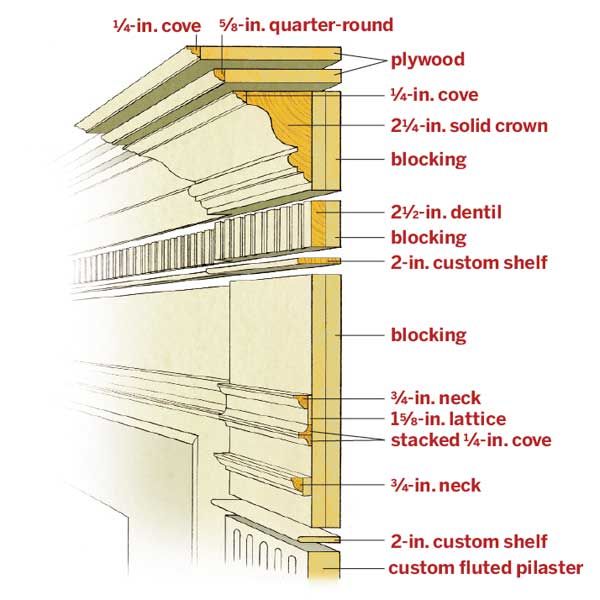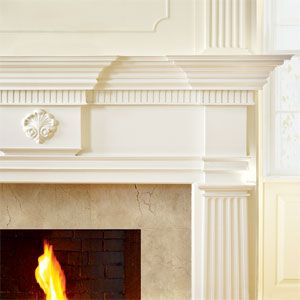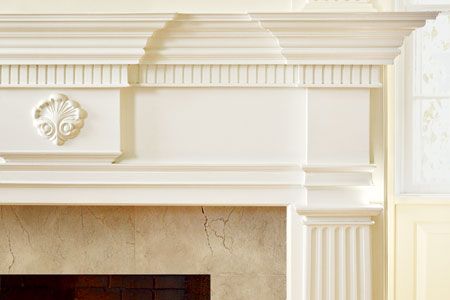

Creating a custom mantel using molding profiles can transform your living space, adding depth and character to your fireplace. While it may appear to be a single piece of art, the mantel pictured here is actually composed of various molding profiles layered together. This guide will walk you through the process of designing and constructing your own mantel, from understanding its components to applying the finishing touches.
Understanding the Anatomy of a Fireplace Mantel
Before diving into the construction process, learn the basic structure and components of a fireplace mantel.
Key Components of a Mantel
A typical fireplace mantel consists of several main parts:
- Mantel shelf: The horizontal surface at the top of the mantel
- Legs or pilasters: Vertical supports on either side of the fireplace opening
- Frieze: The horizontal section between the legs and below the shelf
- Crown molding: Decorative trim at the top of the mantel
- Base molding: Trim at the bottom of the mantel legs
Common Molding Profiles Used in Mantels
You can combine various molding profiles to create a unique and visually appealing mantel. Most of these profiles will be cornices applied along the frieze and legs of the mantel. Some popular options include:
- Crown molding: Adds a concave or convex decorative top edge to the mantel
- Dentil molding: Tooth-like pattern with repeating block shapes for added detail
- Egg-and-dart molding: Alternating ovals and arrow or V-shapes
- Cove molding: Provides a concave profile for depth and shadow
- Quarter-round molding: Simple, rounded edge
Planning Your Mantel Design
Careful planning is essential for a successful mantel project. Take time to consider your home’s style and the overall look you want to achieve.
Choosing the Right Style for Your Home
When selecting a mantel style, consider the following factors:
- Your home’s architectural style, such as traditional, modern, or Craftsman
- Existing trim and moldings in the room
- The size and proportion of your fireplace
- Your personal preferences and design aesthetic
Techniques for Creating Architectural Interest
As you peruse your molding options, consider how you’ll combine them. To elevate your mantel design, incorporate techniques that add visual appeal and dimension.
Incorporating Shadow Lines
Shadow lines, which provide the appearance of depth to a design, can be created by:
- Slightly offsetting layers of molding
- Using contrasting molding profiles
- Incorporating recessed panels in the frieze or legs
Adding Decorative Elements
In addition to using cornices, consider these options to enhance your mantel’s appearance:
- Corbels or brackets under the mantel shelf
- Fluted pilasters on the legs
- Carved medallions or appliques in the frieze
Measuring and Sketching Your Design
Accurate measurements are key for a well-fitted mantel. Note that there are International Residential Code (IRC) regulations for how far combustible materials (like a wood mantel) must be from the fireplace opening. Also check local building codes, which supersede the IRC if they’re more strict. Follow these steps to create your ideal design:
- Measure the width and height of your fireplace opening.
- Determine the desired overall dimensions of your mantel, including width, height, and depth. Typically, a mantel extends 3–6 inches around the fireplace opening, and the shelf is 6–8 inches deep.
- Sketch your design, including the placement of different molding profiles.
- Create a detailed materials list based on your sketch and measurements.
Choosing a Mantel Material
As you choose different types of molding to assemble for your mantel, you’ll need to decide between wood and a composite material like medium-density fiberboard (MDF). Natural wood is more durable and can be sanded and refinished, but it’s the more expensive option. Additionally, neat joining requires carpentry experience. Poplar is a good and relatively inexpensive choice for a fireplace, but oak, maple, and pine are also common.
MDF is composed of wood fibers mixed with resin and formed into panels. It is lighter and easier to work with than natural wood, since it’s smooth and uniform in appearance, but it also has a shorter lifespan. If budget or DIY skills are a concern, MDF is the better option, and some kinds are specifically made to be fire-retardant. If you wish, you can mix materials, using large MDF panels for the base structure and natural wood for the decorative elements. They will look the same once painted.
Essential Tools and Materials for Mantel Construction
Gathering the right tools and materials before you begin will ensure a smooth construction process.
Required Tools
- Miter saw
- Table saw
- Hammer
- Drill
- Level
- Measuring tape
- Pencil
- Safety glasses and dust mask
Recommended Materials
- MDF or solid wood boards for the base structure
- Various molding profiles (crown, cove, dentil, etc.)
- Wood glue
- Pocket screws/pocket hole jigs (for solid wood)
- Finishing nails
- Wood filler
- Mounting brackets and screws
- 2 x 4 lumber (for optional cleats)
- Sandpaper (various grits)
- Primer and paint
Step-By-Step Guide To Building Your Mantel
Now that you have your design and materials ready, it’s time to start building your custom mantel.
Preparing the Base Structure
- Cut the MDF or wood boards to size for the mantel shelf, legs, and frieze. Wear your safety glasses and mask, since MDF in particular creates a lot of dust.
- If you’re using MDF, assemble the basic frame using wood glue and finishing nails.
- If you’re using natural wood, we recommend using pocket hole jigs to create invisible joints.
- Ensure the structure is square and level.
Applying the First Layer of Molding
- Cut the base molding for the legs and attach it using wood glue and nails.
- Install the crown molding along the top edge of the mantel shelf.
- Add any additional molding to the frieze or legs.
Adding Depth With Additional Molding Profiles
- Layer smaller molding profiles on top of the base layer to create depth.
- Use wood glue and small nails to secure each piece.
- Fill nail holes with wood filler and allow to dry.
Tips for Installing Your New Mantel
Proper installation ensures your mantel is secure and looks its best.
- Locate and mark wall studs.
- Use a level to ensure the mantel is straight both horizontally and vertically.
- Check that the mantel is centered over the fireplace opening.
- Use heavy-duty mounting brackets to attach the mantel to the studs. Or, for extra security, install lengths of 2 x 4 as cleats to the wall where the shelf and legs will sit, then secure the mantel to these cleats.
If you’re unsure about the installation process, check out our instructions for how to install a mantel for detailed guidance.
Finishing Touches for Your Mantel
Once the mantel is in place, proper finishing creates a polished, professional look.
Sanding and Priming
- Sand all surfaces thoroughly, starting with coarse-grit sandpaper and progressing to finer grits.
- Wipe away dust with a tack cloth.
- Apply a high-quality primer suitable for your chosen paint type.
Painting and Sealing
- Choose a paint finish that complements your room’s decor (e.g., semi-gloss, satin).
- Apply paint evenly using a brush or roller, following the manufacturer’s instructions.
- Allow paint to dry completely between coats.
- Consider applying a clear protective sealer for added durability.
Additional Tips for Mantel Decoration and Style
Aside from molding and structure, consider other design elements you may want to integrate into your mantel for a more customized look.
Integrating Lighting Features
Adding lighting can dramatically enhance the ambiance and highlight your mantel’s intricate details.
- Consider installing LED strip lights underneath the mantel shelf for a subtle glow.
- Use wall sconces on either side of the mantel to create symmetry.
- In larger rooms, pendant lights installed over the mantel can create a dramatic focal point.
Selecting Accessories and Decor
Your mantel decoration should reflect your personal style while complementing the room’s decor.
- Use vases, candles, and plants to add seasonal touches or year-round greenery.
- Consider a statement mirror above the mantel to add depth and light to the room.
- Rotate seasonal displays like fresh flowers for spring or gourds for fall.
Maintaining Your Custom Molding Mantel
Regular maintenance will keep your mantel looking beautiful for years to come.
Regular Cleaning Methods
- Dust regularly with a soft, dry cloth.
- For deeper cleaning, use a slightly damp cloth and mild soap solution.
- Avoid harsh chemicals that may damage the paint or finish.
Addressing Wear and Tear
- Touch up any chips or scratches promptly with matching paint.
- Inspect for loose molding pieces and reattach if necessary.
- If you used natural wood, consider refinishing every few years to maintain a fresh appearance.
Our Conclusion
By carefully planning your design, selecting quality materials, and following proper construction techniques, you can craft a beautiful and unique custom mantel for your fireplace. If you’re not confident in your abilities or don’t have the necessary tools, consider hiring a professional or exploring alternative options like building a stone veneer fireplace surround. Whichever route you choose, a well-crafted mantel will provide years of enjoyment and add value to your home.

